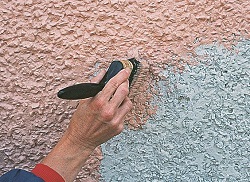
Paint Tips, Tricks, Techniques & Expert Advice
- All unpainted surfaces must ALWAYS be primed.
- Prior to painting your walls a new colour, it is important to paint a white basecoat beforehand. Especially when your original colour is yellow!
- It is essential to paint a white background on your painted or raw plaster wall when painting up colour samples for the true colour. It is highly recommended that a Primer or Undercoat be used (depending on whether it’s a new or painted wall). Having painted your colour samples you have selected, allow the colour to settle for at least 2 to 3 days and view the colours at different times in the day.
- All lighting (including natural sunlight and artificial light) affects the colour of your paint as do shadows in a room.
- A “tint” is when you add white to a colour and a “shade” is when you add black.
- Colours that sit opposite each other on the colour wheel are complimentary e.g. red and green, whilst monochromatic colours are colours that work well with each other and are harmonious.
- Stir paint with a flat-surfaced paddle to mix it properly.
- Sand in a circular motion to provide the most adhesive surface possible.

- A reflective sheen finish in a small room with low light will have the same effect!
- Pre-wet plants or any vegetation to protect them before removing paint outdoors.
- A Matt finish has the effect of making a small room with lots of light appear larger.
- Sand between coats of varnish when varnishing wood to remove any exposed fibres.
- Clean and rinse walls with Polycell Sugar Soap before applying a primer or top coat.
- Multi-Surface Primer contains no lead, chromate, or other toxic ingredients.
- Universal Undercoat can be thinned with maximum 10% of Mineral Turpentine.
- Use a canvas dropcloth to cover flooring or carpets. Canvas is the better option as it won’t puncture or rip.
- Make any necessary repairs, such as filling cracks, etc., well in advance, so these have time to dry thoroughly.
- Make sure to cover and protect surfaces such as skirtings, woodwork and windows by taping off with masking tape.
- The primer coat improves the adhesion of subsequent coats of paint to the specified surfaces, once they have been cleaned and primed.
- Sugarsoap is a neutral, all-purpose cleaning agent that can be used to clean carpets, tiles, baths, toilets and cars and can even be used to unclog drains.
- Paint walls from right to left if you’re right-handed (left to right if you’re left-handed) so that you don’t place your free hand on the wall when applying more paint to a brush or roller.
- Does your newly-painted room still smell of paint? Ensure that the room has enough ventilation to aerate, otherwise one trick is to place saucers of vanilla essence in all four corners of the room.
- If you don’t like the colour of your pine, stain it in a dark teak methylated spirits-based stain before you mix a white glaze.
- If you’re working on pine or wood with a grain, sand with 120-grit sandpaper from top to bottom.
- Before you start, check the condition of the surface you want to paint. There may be various surface problems, such as cracks.
- Never paint over a problem! Browse through the common problems section of this website and follow the solutions provided.
- Once you have checked your surface always remember, preparation comes first. Find your surface in the surface preparation section of this website and prepare accordingly before you paint.
- To determine what kind of paint (water-based or solvent-based) was previously used on a surface, conduct a test patch on a small area using a cloth and methylated spirits. If the coating is removed then it is water-based; if no paint is removed then it is solvent-based!
- Identify your surface and the corresponding products that can be used on it.
- Choose your product according to its quality, the benefits you require, and its all-round match to the task at hand.
- When deciding to tile first or paint first, this will depend on personal preference. Our advice would be to tile first and allow the tile cement and grouting to completely cure. Then cover the tiles with drop-sheets and masking tape before painting. It would be much easier to cover a floor when painting than to cover walls while doing the tile work.
- Whether an existing paint coating is water-based or oil-based, the sheen level influences the preparation and paint system. New paint coatings do not adhere to any existing coating where there is sheen. For example, if you have an existing coating of water-based Double Velvet and would like to apply a new coating of the same, sanding of the sheen to a flat / matt finish would be required.
Please feel free to contact Country Wide Walling today for a free quotation on all your walling requirements.

